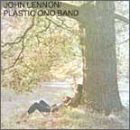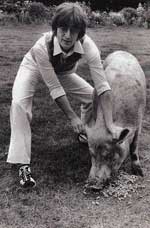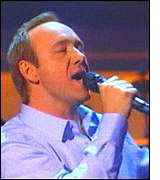This fall marks the 30th anniversary of John Lennon’s Imagine, the album or rather the title song that has come to define the legacy of the performer who has been dead now for over twenty years. Coinciding with the album’s anniversary, a two-hour Lennon tribute was staged October 2 at Radio City Music Hall. Originally organized by Yoko Ono to benefit gun control, COME TOGETHER: A Night For John Lennon's Words & Music became the first of many emotional benefits for World Trade Center survivors. In the wake of the September 11 disaster, the song has become an anthem of optimism and a hymn to humanism for many.
Although Lennon’s words are as fitting as any, a disturbing portrait of the man is emerging. Much like Jesus’ words are often bandied about, Lennon’s are taking on the same stature. Within our religious lexicon, there isn’t much difference these days between "Imagine all the people living life and peace" and "Love thy neighbor as thyself." However, Lennon was always quick to point out his own humanity—except for when he was suffering from the odd Messiah complex—and spent a life debunking belief in anything but oneself. For this reason, the deification of Lennon is particularly offensive and obfuscates a life devoted to personal honesty—an honesty that was on full display on his second solo album.
Imagine, released in September 1971, capped a fierce creative period for Lennon that began in 1969. In September of that year, Lennon, supported by the Plastic Ono Band, played live (in Toronto) for the first time since the Beatles’ final performance over three years earlier. One month later, he released "Cold Turkey," a driving song documenting his struggle with heroin addiction. "War Is Over! (If You Want It)" followed that Christmas and in early 1970, "Instant Karma," his first collaboration with Phil Spector, was released. Soon after the success of Lennon’s dynamic single, McCartney announced the breakup of the Beatles. Lennon’s first solo album, John Lennon/Plastic Ono Band followed several months later.
 Released in December 1970, John Lennon/Plastic Ono Band was a remarkable album. Partially a result of primal scream therapy with Dr. Arthur Janov, JL/POB was an emotional outpouring put on record. With howling screams of "Mother," tales of "Isolation," and a song called "My Mummy’s Dead," it was perhaps too much pain to be popular. Although it stands today as Lennon’s epic—Spector’s stark, cutting production matched the lyrical mood—and one of the most real and confessional albums ever made, it was a commercial failure at a time when fiscal success was very important for a newly ex-Beatle. Lennon next released another single, "Power to the People" (included on last year’s remastered edition of JL/POB), meant to be an anthem in the tradition of "We Shall Overcome" and his own "Give Peace a Chance." The song, however, never met that type of reception (Lennon envisioned crowds of people marching down the streets, fists in the air, shouting the chorus) and at least on that level was a failure.
Released in December 1970, John Lennon/Plastic Ono Band was a remarkable album. Partially a result of primal scream therapy with Dr. Arthur Janov, JL/POB was an emotional outpouring put on record. With howling screams of "Mother," tales of "Isolation," and a song called "My Mummy’s Dead," it was perhaps too much pain to be popular. Although it stands today as Lennon’s epic—Spector’s stark, cutting production matched the lyrical mood—and one of the most real and confessional albums ever made, it was a commercial failure at a time when fiscal success was very important for a newly ex-Beatle. Lennon next released another single, "Power to the People" (included on last year’s remastered edition of JL/POB), meant to be an anthem in the tradition of "We Shall Overcome" and his own "Give Peace a Chance." The song, however, never met that type of reception (Lennon envisioned crowds of people marching down the streets, fists in the air, shouting the chorus) and at least on that level was a failure.
Whether it was conscious or not, Imagine (released September 1971) was laced with an optimism vacant on his first album. In the title song, the tortured artist had been replaced by a dreamer, and instead of isolation there was now a "brotherhood of man." Even a song like "Crippled Inside" ("One thing you can’t hide is when you’re crippled inside") felt more like a celebration than an emotional downer. And the production—again courtesy of Spector—was buoyant with lush strings swelling under many songs. This was a kinder, softer Lennon—at least on the surface. And it reflected in album sales. Lennon had himself a hit.
But like his previous album, the range of emotions present gave Imagine its real dimension. "Gimme Some Truth," the B-side’s first song, was as much a Lennon proclamation as "Imagine," but existed in the here and now as opposed to wishful thinking. "I’m sick and tired of hearing things from uptight, short-sighted, narrow-minded hypocrites," the song begins. George Harrison on slide guitar and Nicky Hopkins on piano gave the pointed lyrics an extra spike. "All I want is the truth/just gimme some truth," Lennon repeats as the chorus.
Lennon had always possessed a healthy cynicism that often provided a needed counterbalance to McCartney’s sweetness and his own almost-childish optimism. The bite of "Sexy Sadie," Lennon’s anti-Maharishi song, or the dark imagery of "I Am the Walrus" gave a much-needed perspective to the utopian "All You Need Is Love"; together, they offered a picture of someone who simultaneously had their head in the clouds and feet on the ground. An oft-used example of Lennon’s ability to add salt to McCartney’s sugar was his response to Paul’s line, "I’ve got to admit it’s getting better," from "Getting Better" off of Sgt. Pepper’s. Lennon replied: "It can’t get much worse."
If Lennon was looking for something to offset the rose-colored cheer of "Imagine," he certainly found it in "How Do You Sleep?", one of the most straightforward attacks in music history. By ‘71, Lennon and McCartney had been quarreling for a few years. Lennon believed that Paul had slighted his wife Yoko from their Beatle days, and was also angered by his official announcement of the Beatles’ breakup. Having left the group six months earlier, Lennon had agreed to wait to break the news. A number of business tensions caused by legal action concerning the group added to the friction; McCartney had in fact sued the other three Beatles over the business management of their affairs.
 |
 |
However, a perceived dis from McCartney’s previous album, Ram, had perhaps set the actual stage for a Lennon attack. "Too Many People," the opening track from Paul’s second album, contained vague references that Lennon read as attacks. Was "Too many people are going underground" a reference to his political activity? The refrain "You took your lucky break and broke it in two. That was your first mistake," could possibly be read as a stab at John’s leaving the Beatles. Perhaps only Paul knows the true answer, but Lennon definitely took them as criticisms and that was all the excuse he needed to launch a counterattack.
McCartney had inadvertently unleashed a beast. Beginning with the line "So Sgt. Pepper took you by surprise," "How Do You Sleep?" was as specific as Lennon could get without actually naming Paul in the song. "Those freaks was right when they said you was dead. The one mistake you made was in your head," Lennon sang in a reference to the "Paul is Dead" conspiracy that arose in the late ‘60s. "The only thing you done was yesterday, and since you’re gone you’re just another day" named Paul’s most famous song and then dismissed his first post-Beatles single. "The sound you make is muzak to my ears" was just plain mean.
These pointed remarks were all enforced by the song’s chorus "How do you sleep? Ah, how do you sleep at night?" Brotherhood of man, indeed. Surely, the fact that George Harrison was playing guitar (slide) on the track reinforced the venom. George had been the first ex-Beatle to launch a personal attack in song and it, in fact, was aimed at McCartney. "I Don’t Need No Wah-Wah" from All Things Must Pass was often misinterpreted for George’s commentary on his own style of guitar-playing but was actually his riff on what he perceived as Paul’s incessant bitching during recording sessions.
Lennon would later make light of "How Do You Sleep?" suggesting that it was only a joke, and his parody of Ram’s album cover included on the inside of Imagine perhaps backs this up. But the real point of discussing this song is the balanced portrait it provides of the real John Lennon that we find on record. He could sing lines like "Imagine all the people living in peace" and "the world will be as one" and seven songs later offer a nasty personal attack, joke or not, aimed to hurt. Lennon was capable of idealism and realism, love and hurt at the same time; in other words, he was painfully and utterly human.
Yet Lennon’s human side is conspicuously absent in portraits of the man today. The most recent example of this revisionism came October 2, 2001 at Radio City Music Hall. COME TOGETHER: A Night For John Lennon's Words & Music included a few older music stars (Lou Reed, Billy Preston) but by and large was intended to show a new generation in touch with Lennon’s music and message. Present were the Stone Temple Pilots, Dave Matthews, Alanis Morrisette, Rufus Wainwright, Moby, Sean Lennon, and a host of performers—Craig David, Marc Anthony, Cyndi Lauper, Shelby Lynne, Shaggy—woefully incapable of capturing any of the power of these songs.
Sprinkled amidst these performances were introductions from entertainers and commentary from host Kevin Spacey and either film or audio of Lennon speaking. Needless to say, everything was of a laudatory nature. Whether it was from Lennon’s mouth or not, the picture presented was of the composer of "Imagine," the peacenik who preached love and one world. Watching the close-ups of celebrities like David Copperfield or Richard Gere, beatific smiles pasted on their faces, or listening to the fawning odes offered at the feet of the increasingly abstract Lennon, one couldn’t help but be struck by the irony but also the unfairness of the situation.
Ironic because Lennon spent a lifetime trying to debunk belief in a higher power, whether it was Jesus Christ or the Mararishi Mahesh Yogi, or just God in general. The very man who wrote "God is a concept by which we measure our pain" ("God" from Plastic Ono Band) and mocked Dylan for converting to Christianity in "Serve Yourself"1 (from the Lennon Anthology) was now being feted much like a deity. It seemed unfair to someone who had always expressed wishes otherwise. Clips of Lennon talking in between performances were eerily like quotations of scripture all taking place in an auditorium much like a cathedral. As the evening slouched along, it took on more and more the air of a worship service. Where was the Book of Lennon?
 But the real offense of October 2 certainly came when the self-consciously smug Kevin Spacey took the microphone and belted out a version of "Mind Games." Clinching the microphone with two hands, knees bent, and head back, he seemed to be acting out his rockstar dreams, as if he were in front of his bedroom mirror instead of the packed Radio City Music Hall. Roll over Lennon, tell Chuck Berry the news: rock and roll is really, really dead. It was all pretense and so at odds, like much of the evening, with what John Lennon stood for—a certain honesty in his life and music—that it actually was the most fitting performance of the night. Well, why not?
But the real offense of October 2 certainly came when the self-consciously smug Kevin Spacey took the microphone and belted out a version of "Mind Games." Clinching the microphone with two hands, knees bent, and head back, he seemed to be acting out his rockstar dreams, as if he were in front of his bedroom mirror instead of the packed Radio City Music Hall. Roll over Lennon, tell Chuck Berry the news: rock and roll is really, really dead. It was all pretense and so at odds, like much of the evening, with what John Lennon stood for—a certain honesty in his life and music—that it actually was the most fitting performance of the night. Well, why not?
In a 1980 interview recently published in Vanity Fair, Lennon stated:
It’s hard to be Gandhi or Martin Luther King or to follow them. I don’t admire politicians particularly, I think they’re showbiz people, but people who put their thing on the line, like Gandhi, and threw the British out by not shooting anybody… those are the political people I admire. But I don’t want to be shot for it like Gandhi, and I don’t want to be shot for it like Martin Luther King. I don’t want to be a martyr, I don’t believe in martyrs, but I admire their stance.
Of course, Lennon was shot, and fairly or not, has since taken a place of martyrdom beside Gandhi and King. And, of course, there’s nothing wrong, even something right, to preaching some of the things that he had to say in music and life—like his admonitions of peace and love. But, and this may be the most important thing to remember, it is essential to include everything he had to say; otherwise, Lennon will become what he always railed against.
In his song "God," at the end of a long laundry list of things he didn’t hold belief in (Jesus, Kennedy, Buddha, Elvis, Zimmerman, Beatles), Lennon sang: "I just believe in me (Yoko and me) and that’s reality." Perhaps it’s time to revise the lyrics (at least in our minds) and add Lennon to the long list of subjects to profess disbelief in and remember the man—the conflicted and contradicting one we see in Imagine and elsewhere—instead of the myth of the holy seer perpetrated on October 2 and generally in popular culture. Otherwise, pain becomes separated from pleasure, reality from dream, truth from lies, and Lennon from legend.
ENDNOTE
1. You say you found Jesus Christ
He’s the only one
You say you found Buddha
Sitting in the sun
You say you found Mohammed
Facing to the east
You say you found Krishna
Dancing in the seats
…You gotta serve yourself
Nobody else is gonna do for you?
You gotta serve yourself
Nobody’s gonna do for you.
"Serve Yourself"—Lennon Anthology